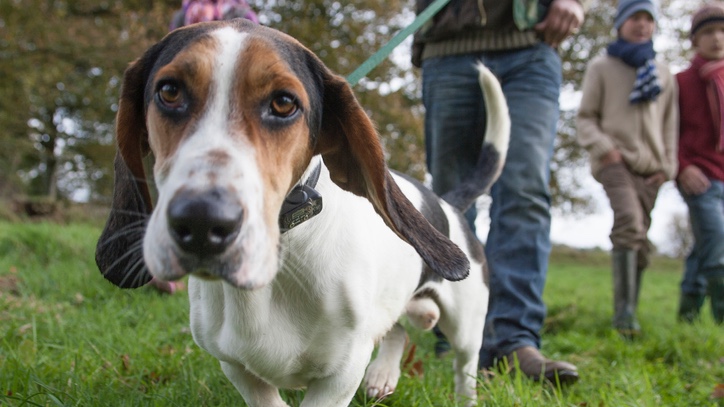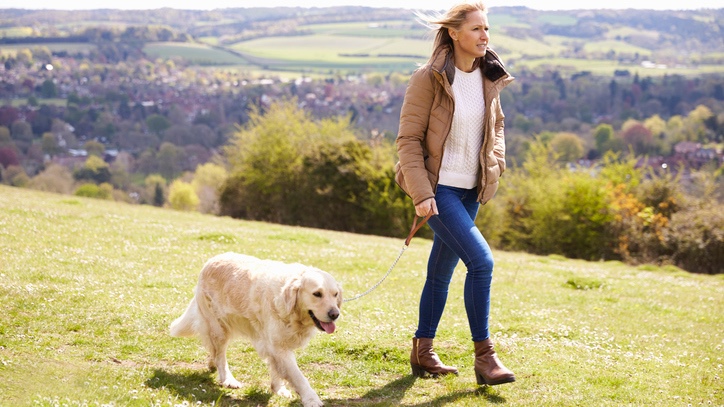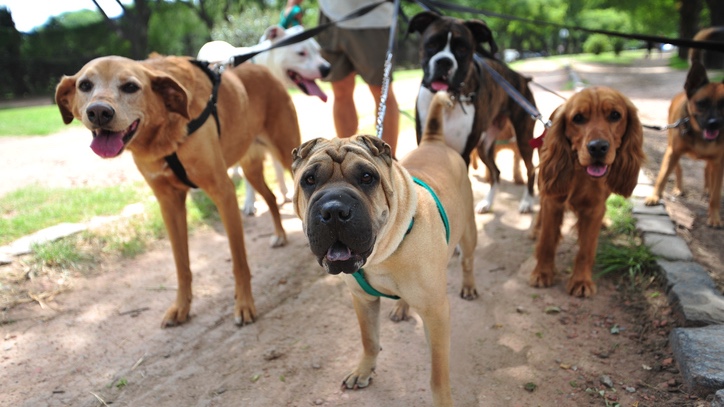How often should I walk my dog?
Wondering "how often should I walk my dog?". The answer is about to be unleashed!

"How often should I walk my dog?" is a much-pondered pooch-related question. In asking, pup owners understand the importance of exercise but they're also wary of over or under-doing it, just in case there is risk of dogs packing on the pounds and becoming unfit or potentially risking injury.
What is certain is that the rules are different depending on the breed you have. It's not a case of the more active a dog is, the better either. We all have our limits, dogs included, and there is a danger that you can cause ill-health among some breeds if you push them too hard.
Here, then, we look to offer advice that best suits your circumstance, taking into account all manner of issues such as age, fitness levels and even enjoyment. We also bear in mind that dog walking is not just about getting those four legs moving either. It's important for other reasons too.
- Do you know why you should let your dog sniff on a walk?
- How to stop a dog from pulling on a leash
- How to become a dog walker: Five steps to help you on your way
Benefits of regular dog walking
In many ways, the benefits of regular dog walking are similar to the advantages of human exercise. In essence, it keeps your pooch fit and healthy. By burning calories, walking can help to prevent dogs becoming obese, something which affects a third of canines. It can also head off a wide range of health problems such as osteoarthritis, insulin resistance, cardiovascular and liver disease, cancers, hypertension, diabetes and even urinary bladder stones.
Indeed, when dogs are taken on regular walks, they get into a cycle and learn when they can relieve themselves. It lowers the potential of bladder and urinary tract infections and, because walking is beneficial in aiding digestion, it also helps to prevent constipation. What's more, walking is great for a dog's muscles and joints and it has a beneficial impact on their mind too. While you may think allowing a pooch to potter around the garden is more than sufficient, they're not taking in the sights and sounds of different neighborhoods or fresh environments. So grab the best dog harnesses or the best dog leashes and get ready for an adventure.
Of course, regular dog walking is great for you too! Not only will it help to keep you in shape by improving your cardiovascular fitness and lowering your blood pressure, dog walking is known to de-stress canine parents and give you a social connection – you are more likely to chat to a stranger when you have a dog by your side and that can even lead to friendship. Walks firm the bond between you and your dog as well. Oh, and it's good fun (most of the time – torrential rainy days excluded!).

How long should I walk my dog for?
The general advice is that you take a dog for a walk for anywhere between 15 minutes and two hours each day – aiming for about an hour for healthy adult canines. And yes, that is a broad time range which is why you need to consider the dog's breed, size and activity levels. A walk doesn't usually need to be undertaken in one chunk – after all, who has two hours to spare each evening for breeds that require this? By splitting the walks over two or three sessions, you're establishing a routine that doesn't feel like a burden.
So which breeds are at the higher end and which at the lower? According to the Kennel Club, Labrador Retrievers, Golden Retrievers, Border Collies, Rottweilers, English Springer Spaniels, boxers, German Shepherds, Dalmatians and Hungarian Viszlas are among those needing two or more hours of exercise. They tend to be the high-energy breeds that are ideal for the more active pet parents and these will be the dogs bred for sport, herding and working.
On the flip side, there are breeds, such as the Great Dane, which prefer to spend the day lazing around and only need 30 minutes or so of exercise. The best small dog breeds and toy dog breeds don't have the energy to cope with much more than half-an-hour either so split those sessions into 15-minute chunks. Be careful with the flat-faced breeds such as the Pug and French Bulldog who have difficulty breathing. Stick to the lower, 15-minute limit for these pups.
Do you need to walk a dog everyday?
Usually, the answer would be yes. Indeed, it's been the advice given for many years and you'll see it written on many websites and in myriad training books. But you won't be a bad pet parent if you skip a day here and there – we all need a rest and your dog will come to no harm.
Niki French, author of Stop Walking Your Dog: A Guide to Training Your Nervous, Reactive, or Over-Excited Pup, certainly says there are times when walking isn't beneficial – when the weather is too hot or cold, for example. She says it may be best to hold off on a walk if you have a bitch in season, a sick dog or new, unvaccinated puppies. Playing games at home with the best dog toys may be more beneficial in some circumstances.
How often should I walk my dog?
And so we're back to the main question. Just how often should you be walking your dog? In many ways, the answer is similar to the one given for how long a dog should be walked: the regularity of the walks will depend on the breed and their size. Age is important too. For puppies, try not to exceed five minutes of exercise per month of age and certainly don't push a puppy beyond the levels recommended for adults.
So what are the recommendations? Well, flat-faced dogs, like the pug, should only be taken out for one walk each day. Stick to 15 minutes and that will be sufficient. Small and toy dogs should be taken for two 15 minute walks each day – the main reason being that they have to keep up a trot if they have hope of matching your pace and that means they're getting more exercise from a walk than larger dogs.
To that end, medium-sized dogs such as Cocker Spaniels, whippets and Chinooks can keep pace so two walks of at least 30 minutes will work well. You could, however, go for a one-hour walk instead or even extend the times to two 40-minute split sessions or a single 80-minute jaunt. Much depends on how quickly your dog appears to get bored. Terriers and herding dogs are generally better with multiple shorter walks.
Larger breeds, and those who are more active, will likely need longer still, so aim for as many as three to four 30 minute sessions daily. Bavarian Mountain Hounds need more than two-hours a day, for instance, so split those into four, while Border Collies, Welsh Springer Spaniels, Jack Russells, Labrador Retrievers and Siberian Huskies can go for 90 minutes – three times each day will be sufficient.

Best time to walk a dog
Some people love mornings and some love nights. The same is true for dogs but, in this case, there can be practical reasons. Imagine, for instance, being a puppy or a senior dog liable to have an accident because bladder control has become difficult. You can bet your bottom dollar that you'd want to be out of that door first thing in the morning!
Whether that means you should be walking your dog at this time is another matter entirely, though. It can be cold first thing and it's not always ideal for muscles and joints. The afternoon tends to be warmer but be wary of taking flat-faced dogs out in sweltering heat because their breathing suffers. The cooler evenings tend to be better and, indeed, it's the most ideal time for most dogs and their owners.
Not only are you able to burn off a dog's excess energy, you're able to de-stress yourself after a busy day and devote more time to the walk (chances are mornings are rushed and you're not around in the afternoon). Night walks are pleasant but they can also be cold and dark in the winter months– if you're looking to mentally stimulate your pup, they're not ideal. In many cases, gauge what your dog is happiest with and avoid the times that cause reluctance. And remember, always practice proper dog walking etiquette.
Can you overwalk a dog?
Overwalking is exactly as it suggests – the act of taking too many steps in a day. And, yes, you can overwalk a dog. Quite what constitutes an overwalk depends on how your pooch was to start with. If they're couch potatoes, then getting stuck into an hour of walking is going to be too much. If your dog is older and you're not embarking on short walks, then again, it could prove tiresome.
It also carries risks. In the case of older dogs, joints and bones could become damaged and, in all dogs, there is risk of feet tear which is painful. Just like humans, there's a risk of stiffness and muscular pain with, in extreme cases, a chance of developing exertional rhabdomyolysis which is when the muscles breakdown through strenuous exercise.
It's also possible that your dog is not walking properly in which case knowing how to use a harness on a dog may come in handy. But if you stick to the recommendations, watch closely for signs of exhaustion and limping, and mix up walks with play, then you should generally have a happy pup racing to grab their leash.
You might also enjoy: Can I go for a dog walk in the rain? and Why does my dog walk sideways?
PetsRadar Newsletter
Get the best advice, tips and top tech for your beloved Pets

David Crookes has been a journalist for almost 30 years and he has written for a host of magazines, newspapers, websites and books including the World of Animals Annual, BBC Earth, Live Science, The Independent and Tom’s Guide.
Born in England, he lives with two cats but he’s also keenly interested in the differences between the huge number of dog breeds – in fact, you can read many of his breed guides that he’s written in collaboration with vets here on PetsRadar.
With a lifelong passion for technology, too, he’s always on the lookout for useful devices that will allow people to keep their pets happier and healthier, and provide them more time to spend together.
David has a degree from Durham University, as well as postgraduate diploma in journalism from the University of Central Lancashire.
